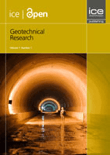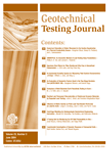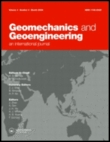
Geotechnical Research
Scope & Guideline
Pioneering research in geotechnical engineering excellence.
Introduction
Aims and Scopes
- Soil Behavior and Mechanics:
The journal publishes research on the mechanical properties and behavior of various soil types under different loading conditions, including undrained shear strength and consolidation behavior. - Geotechnical Engineering Applications:
Focus on practical applications of geotechnical principles, such as the design and analysis of foundations, slopes, and earth structures, often incorporating case studies. - Innovative Materials and Techniques:
Exploration of new materials and techniques in geotechnical engineering, including biogeoscience applications, bio-cementation, and the use of sustainable materials. - Numerical and Experimental Modeling:
Emphasis on the use of numerical simulations and experimental methods to analyze soil-structure interactions, dynamic responses, and failure mechanisms. - Environmental Geotechnics:
Research addressing the intersection of geotechnical engineering and environmental concerns, including waste management, soil remediation, and the impact of construction on land resources.
Trending and Emerging
- Sustainable and Green Engineering Practices:
An increasing number of papers focus on sustainable practices, such as the use of biogeoscience and eco-friendly materials in geotechnical applications, highlighting the importance of reducing environmental impact. - Biogeotechnics and Bio-Cementation:
Research on biogeotechnics, including bio-cementation techniques, is on the rise, showcasing innovative approaches to soil stabilization and improvement that leverage biological processes. - Advanced Numerical Modelling Techniques:
There is a growing emphasis on advanced numerical modeling techniques, such as the material point method and finite element analysis, to better understand complex soil behavior and interactions. - Geotechnical Response to Climate Change:
Emerging studies are increasingly addressing the effects of climate change on geotechnical engineering, including the impact of extreme weather events on soil stability and infrastructure. - Smart Technologies in Geotechnics:
The integration of smart technologies, such as wireless sensors for monitoring and data acquisition, is gaining traction, reflecting a trend towards real-time data utilization in geotechnical assessments.
Declining or Waning
- Traditional Soil Mechanics:
Research focusing solely on classical soil mechanics principles appears to be waning as the field shifts toward more integrated approaches that combine experimental, numerical, and innovative material studies. - Conventional Foundation Design:
There is a noticeable decrease in publications solely addressing conventional foundation design methods, as newer methodologies and materials gain prominence in research. - Localized Case Studies:
While case studies remain important, there is a trend moving away from localized studies towards more generalized models and simulations applicable across various contexts.
Similar Journals

Acta Geotechnica
Shaping the Future of Geotechnical KnowledgeActa Geotechnica, published by SPRINGER HEIDELBERG, is a leading journal in the field of earth sciences and geotechnical engineering, renowned for its rigorous peer-review process and innovative research contributions. With an impressive impact factor and a notable position in the 2023 Category Quartiles as Q1 in both Earth and Planetary Sciences (miscellaneous) and Geotechnical Engineering and Engineering Geology, this journal is pivotal for professionals and academics alike, providing insights that push the boundaries of geotechnical research. The journal features a diverse range of articles, spanning from foundational studies to the latest advancements in sustainable geotechnical practices, making it an essential resource for researchers, practitioners, and students committed to understanding and solving complex geological challenges. The Scopus ranks further affirm its influence, placing it in the 95th and 92nd percentiles of its categories. With no open access options as of now, subscribers gain exclusive access to trailblazing studies aimed at enhancing geotechnical understanding and application globally.

Rock and Soil Mechanics
Pioneering Research for a Sustainable Built EnvironmentRock and Soil Mechanics is a premier academic journal published by SCIENCE PRESS focusing on the critical fields of civil and structural engineering, geotechnical engineering, and soil science. With an ISSN of 1000-7598 and transitioning to an Open Access format since 2020, the journal strives to enhance the accessibility of cutting-edge research to a global audience, making significant contributions to practices and methodologies in these crucial disciplines. Ranked in the Q2 category for Civil and Structural Engineering as well as Geotechnical Engineering and Engineering Geology, and Soil Science, it boasts respectable standings in Scopus rankings, further affirming its relevance and credibility within the scientific community. The journal not only serves as a platform for original research but also engages with the latest advances in technology and innovative applications in rock and soil mechanics, proving invaluable for researchers, practitioners, and students alike as they navigate an increasingly complex field of study.

Periodica Polytechnica-Civil Engineering
Fostering Knowledge for Tomorrow's Engineering ChallengesPeriodica Polytechnica-Civil Engineering is a prestigious journal published by the Budapest University of Technology and Economics, dedicated to advancing the field of civil engineering through high-quality research and innovative practices. Established in 1972, the journal has transitioned through various phases of publication and now spans an expansive range of topics within civil and structural engineering, geotechnical engineering, and engineering geology. With an impact factor indicating its growing influence and a commendable placement in the Q3 quartile according to the latest 2023 metrics, it recognizes contributions that bridge theoretical advancements with practical applications. While currently not open access, the journal remains a vital resource for researchers, professionals, and students seeking to stay abreast of the latest developments in engineering design, construction techniques, and geotechnical innovations. The continuous publication of significant research after almost five decades underscores its commitment to disseminating knowledge crucial for the world’s infrastructure challenges, making it an essential reference point within the engineering community.

International Journal of Physical Modelling in Geotechnics
Pioneering insights for sustainable infrastructure solutions.The International Journal of Physical Modelling in Geotechnics, published by Emerald Group Publishing Ltd, is a leading platform dedicated to advancing the field of geotechnical engineering and engineering geology. With a focus on the practical applications of physical modeling, this journal contributes significantly to the understanding of soil and rock behavior under various conditions, making it invaluable for researchers, professionals, and students alike. Heightened by its Q2 ranking in its category and a notable 61st percentile ranking among its peers, this journal has established itself as a credible source of knowledge and innovation within the academic community. Although it does not currently offer open access, its rigorous peer-review standards ensure the dissemination of high-quality research and insights. The journal, covering a timeline of topics from 2011 to 2024, aims to bridge the gap between theory and practice, ultimately fostering advancements in geotechnical solutions necessary for infrastructure development. To stay at the forefront of geotechnical research, contributing authors and engaged readers are encouraged to explore and participate in this dynamic academic discussion.

Soil Mechanics and Foundation Engineering
Bridging Disciplines for Sustainable Engineering SolutionsSoil Mechanics and Foundation Engineering, published by SPRINGER, is a prestigious academic journal dedicated to the dynamic fields of soil mechanics and foundation engineering. With a history spanning from 1964 to 2024, this journal serves as a vital platform for researchers, professionals, and students looking to advance their knowledge and explore innovative techniques in soil behavior, foundation design, and geotechnical engineering. Although the journal does not currently operate under an open access model, it remains essential for its contributions to key disciplines, notably in energy, geotechnical engineering, ocean engineering, soil science, and water science. Positioning itself in the third quartile of various categories in the 2023 rankings, it reflects a commitment to maintaining rigorous research standards despite its competitive environment. The unique intersection of its scope allows for multidisciplinary collaboration, making it an invaluable resource for those aiming to tackle the challenges in foundation systems and soil interactions in diverse engineering applications.

GEOTECHNICAL TESTING JOURNAL
Empowering Engineers with Cutting-Edge Research InsightsGEOTECHNICAL TESTING JOURNAL, published by the American Society for Testing and Materials, is a premier peer-reviewed journal dedicated to the advancement of geotechnical engineering and engineering geology. With an ISSN of 0149-6115 and E-ISSN 1945-7545, this journal has been a cornerstone in the field since its inception in 1978, spanning volumes released until 2024. Ranked in the Q2 category of the 2023 journal metrics, the journal stands as a significant contributor to Earth and Planetary Sciences, particularly in geotechnical applications, as evidenced by its Scopus rank of #102 out of 229, placing it in the 55th percentile across the database. Offering a wealth of empirical research, technical notes, and innovative practice insights, the GEOTECHNICAL TESTING JOURNAL aims to bridge the gap between theory and practical application, making it an invaluable resource for researchers, professionals, and students eager to contribute to and advance the field of geotechnical engineering.

Indian Geotechnical Journal
Pioneering Research for Groundbreaking Solutions.Indian Geotechnical Journal, published by SPRINGER INDIA, is a premier publication dedicated to the cutting-edge field of geotechnical engineering and engineering geology. With an ISSN of 0971-9555 and an E-ISSN of 2277-3347, this journal serves as a pivotal platform for researchers, professionals, and students seeking to share innovative research and insights that contribute significantly to the development of the discipline. Recognized for its high-quality content, the journal holds a Q2 ranking in the Geotechnical Engineering and Engineering Geology category as of 2023, reflecting its influence and relevance in the academic community. Spanning contributions from 1972 to 1989 and resuming during 2012 to 2024, it showcases a historical depth coupled with contemporary research trends. Despite being a subscription-based journal, the quality of its articles ensures a broad readership, fostering collaboration and knowledge exchange among geotechnical professionals globally. Positioned at the intersection of theory and practice, the Indian Geotechnical Journal aims to advance understanding, encourage innovation, and address the pressing challenges faced in geotechnical engineering today.

JOURNAL OF GEOTECHNICAL AND GEOENVIRONMENTAL ENGINEERING
Championing Open Access Research for Global Engineering ChallengesThe JOURNAL OF GEOTECHNICAL AND GEOENVIRONMENTAL ENGINEERING, published by the ASCE-American Society of Civil Engineers, stands as a pivotal platform for disseminating innovative research in the fields of geotechnical and geoenvironmental engineering. With an impressive impact factor, this journal is ranked Q1 in both Environmental Science and Geotechnical Engineering and Engineering Geology, illustrating its prominence and significant contributions to the scientific community (Scopus Ranks: 38/229 and 48/233, respectively). The journal is dedicated to advancing knowledge and understanding of critical subjects such as soil behavior, environmental sustainability, and the interplay between geotechnics and environmental issues. Operating under the principle of open access, it ensures that vital research is accessible to a global audience, facilitating collaboration and innovation among researchers, professionals, and students alike. Since its inception in 1996, the journal has consistently evolved, with a commitment to maintaining high standards of scholarship and relevance in addressing contemporary challenges in civil and environmental engineering.

CANADIAN GEOTECHNICAL JOURNAL
Advancing Geotechnical Knowledge for a Sustainable FutureCanadian Geotechnical Journal, published by Canadian Science Publishing, stands as a premier resource in the field of geotechnical engineering, focusing on the science and practice of soil mechanics, engineering geology, and related disciplines. Established in 1968, this esteemed journal has earned a distinguished reputation, holding a Q1 ranking in both Civil and Structural Engineering as well as Geotechnical Engineering and Engineering Geology as of 2023. It features a rigorous peer-review process that ensures the publication of high-quality research, making it essential reading for researchers, professionals, and students alike. With an impressive Scopus rank of #63 out of 379 in Civil and Structural Engineering and #41 out of 229 in Geotechnical Engineering, the journal continues to contribute significantly to the advancement of knowledge in geotechnics. While the journal does not currently provide open access options, it remains a vital platform for disseminating innovative findings and fostering academic collaboration in the geotechnical community.

Geomechanics and Geoengineering-An International Journal
Transforming Ideas into Groundbreaking Geotechnical SolutionsGeomechanics and Geoengineering-An International Journal, published by Taylor & Francis Ltd, serves as a prominent platform for the dissemination of innovative research and advancements in the fields of Geotechnical Engineering and Engineering Geology. With an ISSN of 1748-6025 and E-ISSN of 1748-6033, this journal has established itself as a critical resource within its category, ranking in the Q2 quartile according to the 2023 metrics and positioning itself in the top 38% of the Scopus rankings for Earth and Planetary Sciences. Geomechanics and Geoengineering encompasses a diverse range of topics, including but not limited to soil mechanics, foundation engineering, rock mechanics, and environmental geotechnics, ultimately aiming to advance both theoretical and practical knowledge in these vital areas. This journal not only highlights pioneering research but also facilitates a platform for academia and industry practitioners to collaborate and exchange ideas. While it does not offer open access, it remains a valuable resource for institutions and individuals committed to enhancing their expertise in the geotechnical domain. With convergence years spanning from 2006 to 2024, this journal is equipped to significantly contribute to the evolving landscape of geomechanical research.